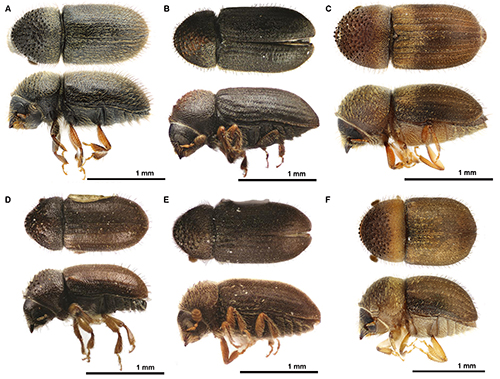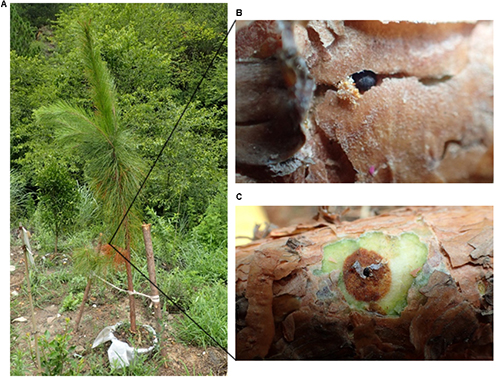common name: bark beetle
scientific name: Cryphalus lipingensis, Tsai & Li, 1963 (Insecta: Coleoptera: Curculionidae: Scolytinae)
Introduction - Synonymy - Distribution - Description - Hosts - Importance - Sentinel plant gardens - Selected References
Introduction (Back to Top)
Cryphalus lipingensis Tsai & Li, 1963 belongs to the bark beetle genus Cryphalus that contains more than 200 species. Five species of Cryphalus are distributed throughout the USA, mostly in northern latitudes (Wood 1982; Johnson et al. 2020). All species native to North America live in dead twigs of conifers, and none of these species is considered an important pest. Cryphalus lipingensis does not occur in North America, but it is widespread in China. The reason for its importance is that it has been reported to colonize and kill American pine species planted in China, namely slash pine, Pinus elliottii, and as such poses a threat to US forests and forestry as a potential invasive pest. As in other bark beetles, most of the life cycle of Cryphalus lipingensis is spent under the bark of infested trees, and their main nutrient resource is the inner bark and phloem. Taxonomically, Cryphalus lipingensis and Cryphalus kesiyae, Browne, 1975 have been recognized as two different species, but molecular phylogeny has shown that Cryphalus lipingensis and Cryphalus kesiyae are the same species (Johnson et al. 2020).
Synonomy (Back to Top)
Cryphalus kesiyae, Browne, 1975 (Johnson et al. 2020)
Distribution (Back to Top)
China (Guizhou, Sichuan, Chongqing, Shaanxi, Yunnan) and Thailand (Beaver and Browne 1975, Chen and Tang 2014, Tian 2018, Johnson et al. 2020, Yang 2020).
Description (Back to Top)
Female. The adult females (Figure 1A) are 1.50 mm to 1.90 mm long and approximately 2.25 times as long as wide. They are brown in color, and there are no scales, but there are abundant hairs all over the body. The beetle forehead (frons) has a densely “scratched” surface (the expert term is aciculate). The antennal club has three lines (marked with hairs) curved downwards. The dorsal and lateral surfaces of the beetle thorax (called pronotum) are visible with abundant tiny projections in the shape of flat teeth. Where most bark beetles have a scutellum – the little triangle in the middle of the wing covers (elytra) where they meet the thorax – the scutellum in Cryphalus lipingensis is mostly hidden and poorly visible. The front legs have hair-like setae.
Male. The adult males (Figure 1B) are 1.50 mm to 1.70 mm long and approximately 2.30 times as long as wide. The male is similar to the female, except it is smaller and the bottom of its head has less hair-like setae. Compared to the adult females, the last segment of the abdomen in males, at the bottom of the body, is smaller and narrower than the body width.
Figure 1. The dorsal, lateral, and ventral surfaces of the adult Cryphalus lipingensis. A) the female individual; B) the male individual. Figure from (Johnson et al. 2020).
Diagnosis (Back to Top)
There are two species of Cryphalus present in Florida: C. itinerans, and C. mangiferae. The most important difference in these species from C. lipingensis is that C. itinerans, and C. mangiferae colonize broadleaved hosts, not pines (figs and paper mulberry, or mango, respectively). The American Cryphalus species that colonize Pinaceae (C. rubentis, C. pubescens, and C. striatulus) do not occur in Florida.
Morphologically, Cryphalus lipingensis can be distinguished from the other Cryphalus species by the combination of the setae status and the “scratched” (aciculate) forehead. Almost the entire body is covered with hair-like setae and the male forehead does not have a transverse ridge (Johnson et al. 2020). The adults of all other American Cryphalus species have scale-like setae on the surface of their bodies. Several more details distinguish Cryphalus lipingensis: Compared with Cryphalus striatulus, Cryphalus rubentis, and Cryphalus itinerans, Cryphalus lipingensis has more broadly rounded eyes, it is more shiny, its body is covered with the hair-like setae, and it has lots of asperities on the declivity (Figure 2).Cryphalus itinerans is much smaller than Cryphalus lipingensis. Cryphalus mangiferae and Cryphalus itinerans have a pronotum (dorsal surface and the first segment of the beetle thorax) with a more rounded top.
Figure 2. The dorsal and lateral photographs of the Cryphalus species. A) The Asian Cryphalus lipingensis; the remaining species are American: B) Cryphalus striatulus; C) Cryphalus mangiferae; D) Cryphalus pubescens; E) Cryphalus rubentis;F) Cryphalus itinerans. Photographs by Andrew J. Johnson, University of Florida.
Another group of bark beetles common in Florida that can be confused with Cryphalus lipingensis is the genus Hypothenemus. Hypothenemus previously belonged in the same group (Crypahlini) but were recently placed in a different tribe (Trypophloeini) based on DNA sequence evidence. Although the male and female of Hypothenemus have a similar forehead to Cryphalus lipingensis, the two sexes are distinctly different from one another, which is key for this genus distinction. Hypothenemus has weakly emarginated (concave at the margin) eyes, the side of the thorax has a raised line, there are abundant hair-like scales on the body (vestiture), and the antennae have a tiny internal black patch (septum, some species, Figure 3). Cryphalus have emarginated third tarsal segments, their body size and antennae (paired sensors on the head, like aerials) are larger, and the hair-like setae on the body are long and dense.
Figure 3. Anterior face diagram showing the antennal difference between Cryphalus lipingensis (left) and Hypothenemus eruditus (right) with septum (black patch). Sketch is redrawn by Yiyi Dong, University of Florida according to the figures from Wood (1982) and Johnson et al. (2020).
Hosts (Back to Top)
The host plants of Cryphalus lipingensis are only Pinaceae trees in China. It has been collected in Pinus kesiya, Pinus armandii, Pinus yunnanensis (Chen and Tang 2014, Johnson et al. 2020), and in the American slash pine Pinus elliottii (unpublished Sentinel Garden experiment data).
Importance (Back to Top)
Cryphalus lipingensis were reported to attack the upper trunk and branches of stressed pine trees in China (e.g. infected with a pathogen, stressed by drought, or freshly dead trees) (Chen and Tang 2014). Our observations in China showed that Cryphalus lipingensis also colonizes the branches of living Pinus yunnanensis (A. S. Ernstsons, Y. Li, J. Hulcr, unpublished data). Most importantly, these bark beetles were detected in living Pinus elliottii (slash pine, Figure 4), experimentally injured but otherwise healthy, planted in an experimental garden in China, which means that if Cryphalus lipingensis establishes in the USA, it may become a pest of economically important pines.
Figure 4. A) Slash pine attacked by Cryphalus lipingensis; B) the damage area with the frass; C) the entrance hole in a green tissue exposed by removal of the bark. Photographs by A. Simon Ernstsons, University of Florida.
Sentinel plant gardens (Back to Top)
The Sentinel plant garden concept uses trees planted overseas to detect potential invasive pests, and to report new potential associations between the host plants and insects. The purpose is to detect and study the pests before they are accidentally transported through international trade. The University of Florida’s Forest Entomology Laboratory has already established several sentinel gardens of American trees in China’s tropical, subtropical, and temperate natural regions, matching the latitudes in the USA (Popkin 2020). The trees are stressed (but kept alive) in each garden by flooding or girdling to test which of the local wood-boring beetles attack the treatment trees. The wood borers that attack trees with high health scores (not dead or stressed) are judged as having a high-risk of being potentially invasive pests. The occurrences of Cryphalus lipingensis on living, stressed Pinus elliottii planted in the sentinel garden in China contribute to assessing this beetle's invasive risk in the USA.
Selected References (Back to Top)
- Beaver RA, Browne FG. 1975. The Scolytidae and Platypodidae (Coleoptera) of Thailand: A checklist with biological and zoogeographical notes. Oriental Insects, 9: 283-211. https://doi.org/10.1080/00305316.1975.10434499
- Chen H, Tang M. 2014. Spatial and temporal dynamics of bark beetles in Chinese white pine in Qinling mountains of Shaanxi province, China. Environmental Entomology, 36:1124-1130. https://doi.org/10.1093/ee/36.5.1124
- Johnson AJ, Li Y, Mandelshtam MY, Park S, Lin CS, Gao L, Hulcr J. 2020. East Asian Cryphalus Erichson (Curculionidae, Scolytinae): New species, new synonymy and redescriptions of species. ZooKeys, 995:15-66. https://doi.org/10.3897/zookeys.995.55981
- Popkin G. 2020. Scientists plant ‘sentinel trees' to warn of devastating pests. American Association for the Advancement of Science, https://www.science.org/news/2020/03/scientists-plant-sentinel-trees-warn-devastating-pests
- Tian S. 2018. Biodiversity and molecular identification of the Scolytinae reinvestigation in Chongqing area. https://cdmd.cnki.com.cn/Article/CDMD-10410-1018275517.htm
- Wood SL. 1982. The bark and ambrosia beetles of north and central America (Coleoptera: Scolytidae), a taxonomic monograph. Great Basin Naturalist Memoirs, 6:1-1359. ASIN: B0000EHANR
- Wood SL. 1984. New generic synonymy and new genera of Scolytidae (Coleoptera). The Great Basin Naturalist, 44: 223-230. https://www.jstor.org/stable/41711753
- Yang, L. 2020. Checklist of the genus Cryphalus Erichson, 1836 (Coleoptera: Curculionidae: Scolytinae) with special attention to Chinese species. Zoological Systematics, 45:176-205. https://doi.org/10.11865/zs.202023



